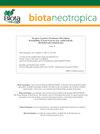巴西圣保罗市阿劳若沙蚤(Sandalodesmus araujoi)集体发生1例及迄今未知雌虫(多丝蝇,切丝蝇科)描述
IF 1.2
4区 环境科学与生态学
Q3 BIODIVERSITY CONSERVATION
引用次数: 0
摘要
许多切蝇科类群具有相同的体细胞特征,传统上的属位和种鉴定都是基于性腺形态。女性生殖器的角色在很大程度上被忽视了,很少被拍照或插图。这是相当不幸的,因为女性生殖器的形态表现出重要的特征,可能是决定性的发展一个更强大的家庭分类。我们描述了迄今为止未知的sanalodesmus araujoi雌性(Schubart, 1946),以前仅从1943年12月在巴西圣保罗收集的雄性全型中得知;讨论了雌性生殖特征在沙蚤种划分中的应用;并报告首例蝶科集体发生的病例。虽然试图根据生殖特征正式诊断沙蚤雌性尚不成熟,但本研究中检查的三个分类群的外阴形态表明雌性生殖器具有物种特异性。一些特征(即不对称的阀,在阀的内部基部存在数字化投影和刚毛减少)在物种之间是恒定的,这表明了通用水平描绘的实用性。千足虫的大量出现通常是不可预测的,可能与环境条件的变化和/或自然栖息地的人为改变有关。虽然本文报道的S. araujoi的大规模发生只观察到一次,但这一事件恰逢巴西雨季千足虫的交配期。另一方面,发现该物种的地区已成为密集城市发展的目标,包括用住宅区取代自然栖息地,这可能影响了其种群动态。本文章由计算机程序翻译,如有差异,请以英文原文为准。
A case of mass occurrence of Sandalodesmus araujoi () in a municipality of São Paulo, Brazil and description of the heretofore unknown female (Polydesmida, Chelodesmidae)
Abstract Somatic characters are shared by many Chelodesmidae groups, and generic placement and species identifications traditionally have been based on gonopodal morphology. Female genitalic characters have been largely neglected and are rarely photographed or illustrated. This is rather unfortunate as the morphology of female genitalia presents important characters and may be decisive for developing a more robust family classification. We describe the heretofore unknown female of Sandalodesmus araujoi (Schubart, 1946), previously known only from the male holotype collected in São Paulo, Brazil in December 1943; discuss the utility of female genitalic characters for species delineation in Sandalodesmus; and report the first case of a mass occurrence in the Chelodesmidae. While an attempt at a formal diagnosis of Sandalodesmus females based on genitalic characters is premature, the vulvar morphology of the three taxa examined in this study suggests that female genitalia are species-specific. Some characters (i.e., asymmetric valves, presence of digitiform projections and reduction of setae on the internal basal portion of the valves) are constant between the species, suggesting utility for generic-level delineation. Mass occurrences of millipedes are typically unpredictable and likely related to variations in environmental conditions and/or anthropogenic modifications of natural habitats. Although the mass occurrence of S. araujoi reported herein was only observed once, the event coincides with the mating period of millipedes during the rainy season in Brazil. On the other hand, the region where the species was found has been the target of intense urban development, including replacement of natural habitats with residential areas, which may have influenced its population dynamics.
求助全文
通过发布文献求助,成功后即可免费获取论文全文。
去求助
来源期刊

Biota Neotropica
BIODIVERSITY CONSERVATION-
CiteScore
2.90
自引率
16.70%
发文量
0
审稿时长
4-8 weeks
期刊介绍:
BIOTA NEOTROPICA is an electronic, peer-reviewed journal edited by the Program BIOTA/FAPESP: The Virtual Institute of Biodiversity. This journal"s aim is to disseminate the results of original research work, associated or not to the program, concerned with characterization, conservation and sustainable use of biodiversity within the Neotropical region.
Manuscripts are considered on the understanding that their content has not appeared, or will not be submitted, elsewhere in substantially the same form, because once published their copyrights are transferred to BIOTA NEOTROPICA as established in the Copyright Transfer Agreement signed by the author(s).
 求助内容:
求助内容: 应助结果提醒方式:
应助结果提醒方式:


